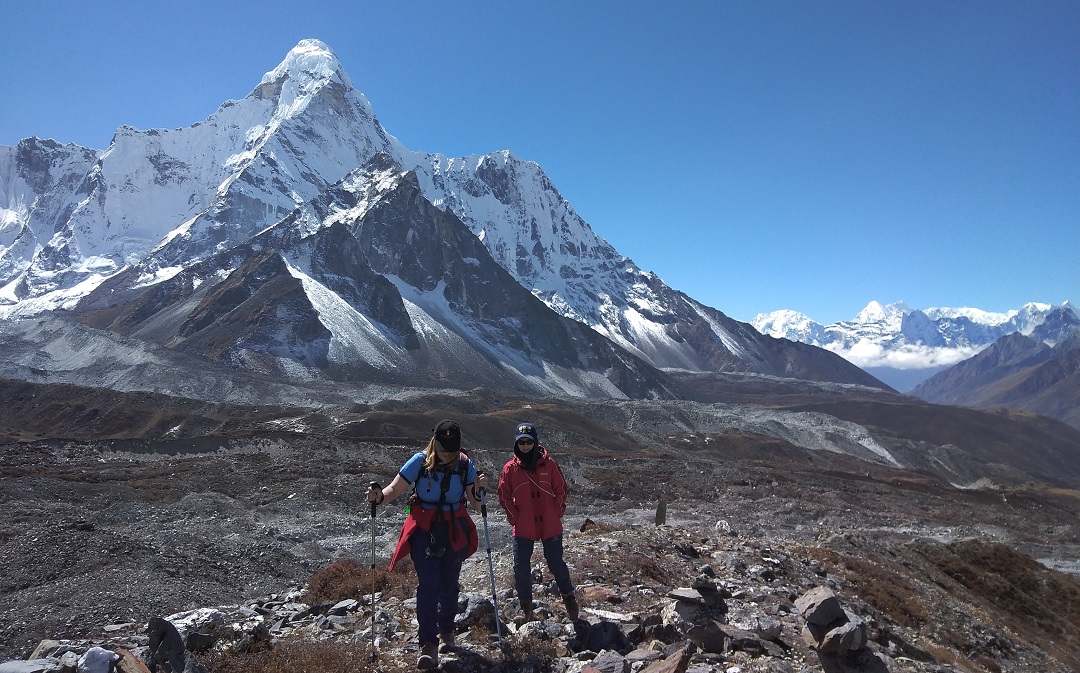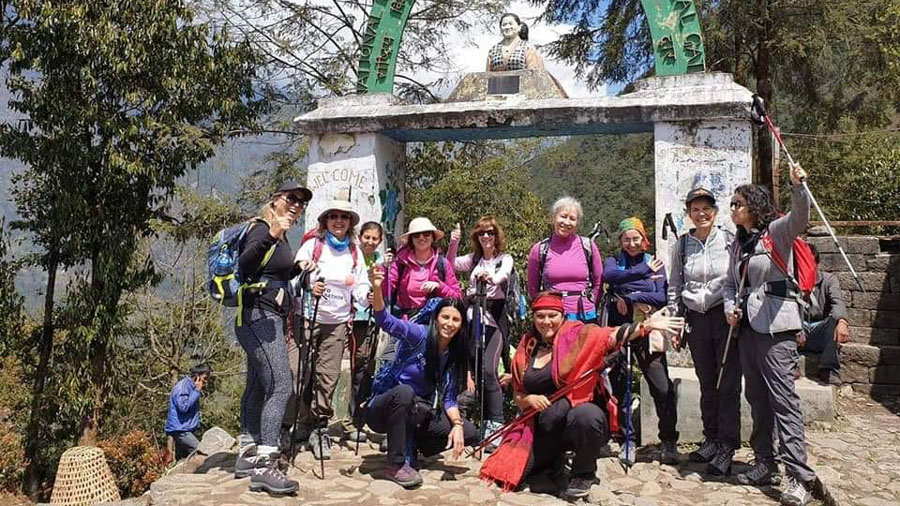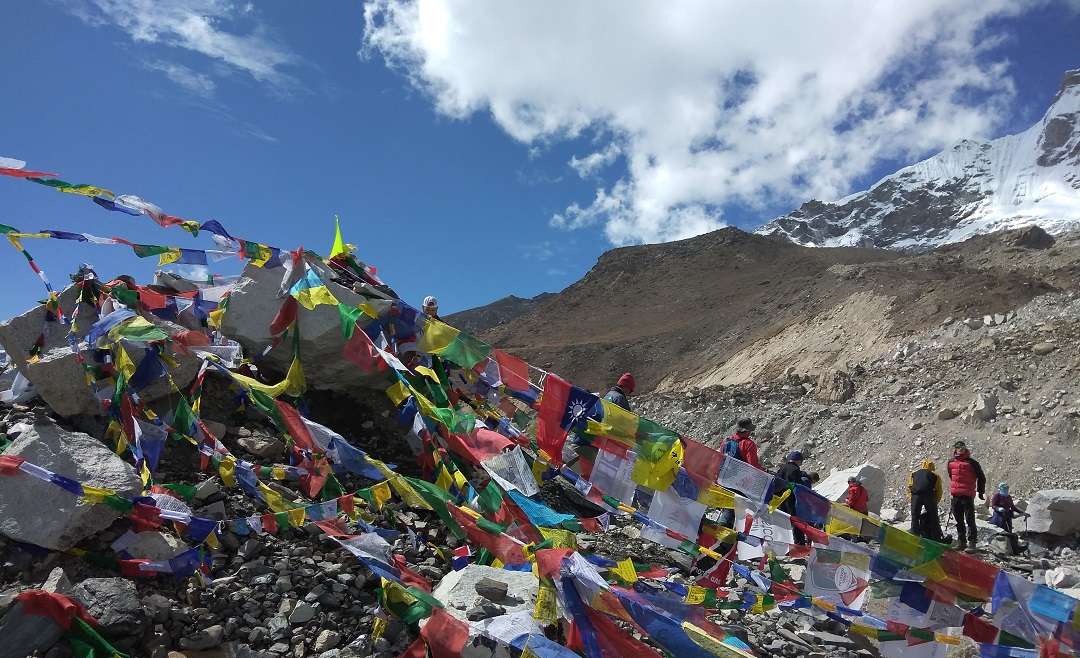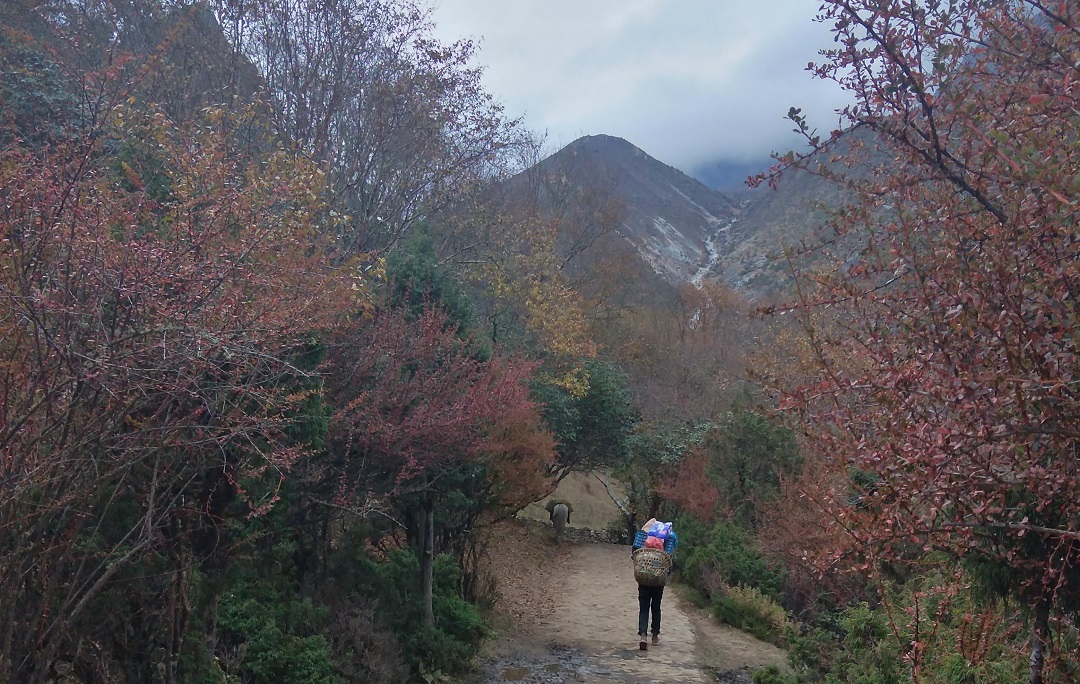
The Everest Base Camp Trek is difficult, but certainly not the most challenging trek when it comes to walking distance and trail condition. If you ascend slowly, prepare well, and have decent fitness, you can do it. This blog compiles all the relevant information that one needs to know to prepare for the Everest Base Camp Trek.
Everest Base Camp Trek Profile

Total length (From Lukla to Lukla): 101 km
Number of days: 12- 14 with acclimatization days
Highest Altitude: 5,643 Meters (Kalapathar) or 5,380 m (Everest Base Camp). About 40 – 50% of people get sick with altitude above 4000 meters. So altitude sickness is a very common problem in Everest Base Camp Trek. And if you want to prepare yourself to sleep at an altitude above 5000 meters, you must take acclimatization seriously.
Daily walking distance: 7-12 km per day on the way up to Everest Base Camp and 15- 22 km per day on the way down [Distances can be confusing because of the altitude, so it will be better to look up the daily walking hours instead.]
Daily Elevation Gain: Not higher than 500 meters above 3,000 meters asl, except for Phakding/ Monjo to Namche Bazaar, where you will ascend about 800 meters. [Please note that we are talking about the altitude gain from one village to another. Practically, will ascend and descend more than that during the hike]
The average duration between night stops: 6- 7 hours.
High Passes Trek: If you wish to do the High Passes Trek or combine it with Everest Base Camp Trek, the altitudes are way higher- Cho La Pass (5,430 m), Kongma La (5,545 m) and Renjo La (5,360 m). They are technical too and require a lot of preparation. So we do not recommend doing the passes on your own.

Difficult Months: Trekking in June/July/August (Monsoon) and January/ February (Winter) is definitely more challenging than other months. The monsoon makes it hard to enter via Lukla Airport, and the trails in the lower sections below Lukla can be extremely slippery welcoming higher risk of injuries. Besides, winter snow can make trails difficult to navigate.
Acclimatization Stops: Namche Bazaar (above 3000 meters) and Dingboche/ Pheriche (above 4000 meters)
Who can do Everest Base Camp Trek?

If you are someone with reasonable fitness and decent hiking experience, you can do the Everest Base Camp Trek. The key is to take it according to your pace and enjoy the trails no matter what the standard itinerary suggests.
We recommend outdoor training to prepare for the Everest Base Camp Trek as you will enjoy the trails at its best only if you are fit. Nothing can replace uphill and downhill walking with weight a little heavier than your actual backpack. So go for a full day or multi-day hikes to get the feel. Try adding cardio and leg exercises to strengthen your knees as a part of your training.
However, if you have any pre-existing conditions, we’ve compiled a list below so you can plan your Everest Base Camp trek accordingly. Please make sure you consult with your doctor to plan your medication as well as your travel agency, guide, or insurance provider if you have any of them.
AVOID if you have these pre-existing conditions:
- Sickle cell Disease- Increased risk of sickle cell crisis.
- Pregnancy- First three months puts the fetus at high risk.
- Pulmonary hypertension- High risk of High Altitude Pulmonary Edema (HAPE)
- Obesity Hypoventilation Syndrome- High risk of Acute Mountain Sickness, High Altitude Pulmonary Edema (HAPE) and heart failure.
- Carotid Surgery- Difficulty/Disability to increase airflow in response to low oxygen content. It might be possible to undertake a trek depending upon the kind of surgery. Thorough consultation required.
- Congenital Heart Problems- High risk of High Altitude Pulmonary Edema (HAPE).
TAKE EXTREME PRECAUTIONS if you have these pre-existing conditions
- Obstructive Sleep Apnea- Travel with a CPAP machine. Supplemental Oxygen required.
- Diabetes- Take readings more often and manage blood sugar level religiously. Make sure your glucose meter will work in extreme cold and high altitudes. Dosage changes might be necessary. Make sure you know the guidelines.
- Chronic Obstructive Pulmonary Disease- Supplemental oxygen might be required. Severe cases should not travel to high altitudes. Bronchodilators are helpful.
- Neuromuscular Diseases- Depends upon the exact nature of the disease.
- Chronic Kidney Disease- Makes it hard to maintain fluid, electrolyte content. Hard to acclimate to low oxygen content. Increased susceptibility to HAPE.
- Cystic fibrosis- Supplemental oxygen, antibiotics, and physiotherapy will help. Depends upon the severity.
TAKE PRECAUTIONS if you have these pre-existing conditions
- Radial Keratotomy- Carry corrective glasses. While laser surgery doesn’t cause problems, avoid high altitudes for 6 months after the surgery. Carry corrective glasses.
- Heart Diseases- Depends upon the type and severity of the problem. Ascend slow and acclimatize well. Take extra days if required. Use Diamox preventively.
- Arrhythmia- Supplemental Oxygen might be required. Avoid exertion.
- High Blood Pressure- Regularly check blood pressure. Take regular medication and do not change the dosage without consultation.
- Anemia- Reduction of physical fitness. Iron supplements might help in certain cases. High altitude performance highly depends on type and severity of anemia.
- Obesity- Slightly higher risk of AMS.
- Epilepsy- Make sure members of your group know what to do in case of a fit.
- Peptic Ulcer- Increase in gastrointestinal bleeding. Avoid alcohol, smoking, caffeine at high altitudes. People with peptic ulcers should avoid dexamethasone unless for treatment of HACE/HAPE.
DON’T WORRY about these pre-existing conditions
- Asthma- Continue with usual treatment. You might actually do better at high altitudes.
- Migraine- Frequency and severity can go up. Continue with regular medication.
Is age a barrier to trek to the Everest Base Camp?

Trekkers from age five to eighty have successfully completed the Everest Base Camp Trek. In short, age is NOT at all a barrier. The most important thing is your will, preparation, and an itinerary that suits your pace. Besides, altitude sickness has nothing to do with age as long as you listen to your body and go slow. However, if you’re travelling with kids, make sure you teach them to communicate about altitude sickness.
Besides, you can always get a porter to carry your backpack if needed.
Do I need a guide or porter?

Although you can do the Everest Base Camp independently, not everyone finds it safe. Having a guide who understands the trail and the know-how around the mountains ensures a better experience and safety. A good guide will check on your health, and even make wise decisions to help you cope with any sickness or injuries. And if you’re only worried about the heavy backpack, you have porters for that purpose. Hiring an independent local guide porter doesn’t even break your bank, and you can trek without compromising on flexibility as well.
Possible Risks and Health Hazards in the Everest Region

Trekking in the mountains is always a risk. If you want to ensure the utmost safety, you must be aware of the possible dangers that might barge in your way. Below are the possible conditions to watch out and prepare for during your Everest Base Camp Trek.
Altitude Sickness
Altitude Sickness is the most common issue seen among trekkers in the Everest Region. Limiting your daily ascents to 500 meters and having a rest day every 1,000 meters is a must. Besides, food rich in carbs, garlic soup, and drinking 4 liters of water daily also helps you perform better at high altitudes. Having said that, diuretics like alcohol and caffeine should be avoided. Read about the Do’s and Dont’s of Altitude Sickness, AMS, HAPE, and HACE in detail here.
Water-borne diseases
Water-borne diseases like diarrhoea and giardia are common if you don’t drink clean drinking water. Make sure you are prepared, so it doesn’t ruin your trip. Drinking boiled water is your safest option, but it can get expensive in the trails. Besides, SteriPEN and chlorine dioxide tablets are other alternatives. Also, make sure to carry the necessary drugs as a backup.
Animals
Don’t worry! By animals, we don’t mean wild, ferocious snow leopard or a Yeti. The trails in these mountains are high and narrow with rivers on one side. Herds of horses, mules, and yaks frequent the trails by carrying heavy loads. And if you are not careful, a little dash is enough to roll you down the cliff. So always stick to the cliffside.
Khumbu Cough
The cold, dry mountain air may cause an irritable sensation in your throat, causing Khumbu cough. The best way to prevent it is by breathing humidified air by using a mask, or buff, and not exposing your chest to the cold wind. Candies or cough drops will help.
Knee problems
Walking uphills and downhills can be tricky. We generally tend to rush ourselves in the downhills, but in fact, it stresses your knees. Using trekking poles properly can make a lot of difference.
Foot Blisters
Blisters are common when you’re walking for days. They’re caused by multiple reasons like not breaking in your shoes, thin socks, and friction if your feet are sweaty. So take necessary precautions and carry moleskin or blister tape.
If you’re trekking in winter or going to the high passes, snow blindness, hypothermia, and frostbite are other issues that you must be careful of. In the Everest Region, a helicopter is your only way out in case of emergencies. So, it is a must to buy Insurance with coverage of up to 6,000 meters and helicopter evacuation.
Emergency Contact Numbers in Everest Region

If there’s any emergency, here’s a list of all the important contact information in the Everest Region one might need.
Medical Services:
Lukla Hospital: +977-38-550119
Mountain Medical Institute, Namche Bazaar: +977-38-540006Khunde Hospital. Khunde: +977-38-540053
HRA Aid Post, Pheriche: +977-1-4440293 (Kathmandu Office)
Local Law Enforcement
Lukla:
Police: +977-38-550005
Airport: +977-38-550044
Namche Bazaar:
Nepal Army: +977-38-540120, +977-38-540220
Police: +977-38-540099
Sagarmatha National Park HQ: +977-38-540114
Permit Counters
Khumbu Rural Municipality Permit Counter, Lukla: 9801842386
Sagarmatha National Park Permit Counter, Monjo: 9801845387
Please find the contact information for Embassies, Consulates and Emergency Rescue in Nepal here.







